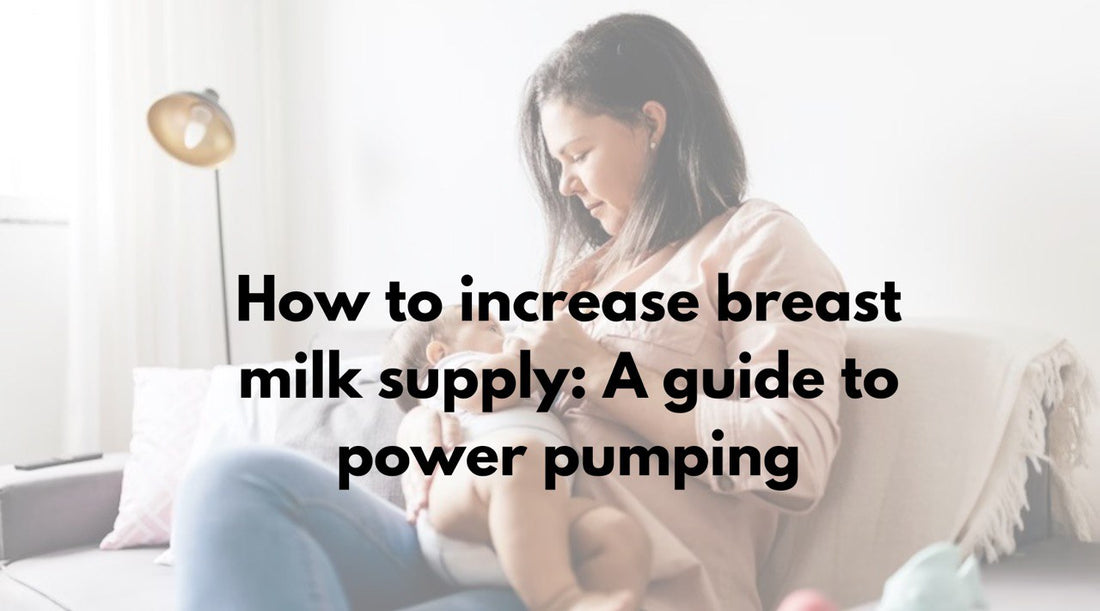
How to increase breast milk supply: A guide to power pumping
Share
How to increase breast milk supply: A guide to power pumping
Power pumping can be a simple, low-risk strategy for parents who want to increase breast milk supply—whether you breastfeed, combo feed, or exclusively pump. It requires no special equipment beyond a pump and some dedicated time. The main commitment is setting aside about an hour a day for several days in a row.
Below you’ll find an easy-to-follow explanation of power pumping, when to try it, and practical tips to help you increase breast milk production.
What is power pumping?
Power pumping is a focused pumping routine designed to stimulate more milk production. By mimicking a baby’s cluster feeding—frequent, short feeds during a growth spurt—you encourage your body to make more milk. The goal isn’t to collect large amounts of milk right away but to trigger the hormonal signals that tell your body to increase breast milk supply.
A power-pumping session is added to your regular pumping or nursing schedule. You’ll typically pump in intervals for about an hour once a day, for five to seven days to increase breast milk.
Reasons to try power pumping
Power pumping is often recommended if you want to increase breast milk supply for these reasons:
-
Your milk supply has dropped and you’d like to build it back up.
-
You want to maximize output before returning to work or being away from your baby.
-
You’re preparing a freezer stash or simply want extra flexibility in your feeding routine.
Before starting, it’s helpful to check for any underlying causes of low supply, such as an ineffective latch or pump parts that need replacing. If you already produce enough milk, power pumping can still increase breast milk supply but may lead to fuller breasts, extra leaking, or occasional clogged ducts. If you’re unsure, consult a lactation professional or your healthcare provider.
How to power pump
Time frame: choose a consistent time each day and commit to one hour of pumping for 5–7 days in a row. Most parents notice an increased breast milk supply after about three days.
Intervals:
-
Classic schedule:
-
Pump for 20 minutes
-
Rest for 10 minutes
-
Pump for 10 minutes
-
Rest for 10 minutes
-
Pump for 10 minutes
-
Alternate schedule:
-
Pump for 10 minutes
-
Rest for 10 minutes
-
(repeat pump/rest for 10 minutes each time until the hour is up)
Don’t worry if very little milk flows toward the end of the session. The stimulation—not the immediate volume—is what signals your body to increase breast milk production.
Equipment tips
-
Double-electric pump: speeds up the process and allows both breasts to be stimulated at once, which is more efficient and helps with hormonal signaling to increase breast milk supply.
-
Single pump or manual pump: you can still power pump by alternating sides. For example, pump one breast for 12 minutes, switch sides for 12 minutes, then alternate back and forth for shorter intervals.
-
Comfortable suction: use the highest vacuum level that feels comfortable. Too much suction can cause pain or nipple damage and may actually decrease milk output.
-
Correct flange size: your nipple should move freely inside the tunnel without rubbing or excess space. Flange size can change over time, so re-check measurements periodically.
Practical tips for success
-
Stay relaxed—read, listen to music, or watch a show while pumping.
-
Keep water and a snack nearby; the extra stimulation may make you thirsty or hungry.
-
Be patient: most parents see results after several days, not immediately.
-
After finishing 5–7 days, return to your regular pumping or nursing routine to let your body adjust. If you’d like to repeat the process to increase breast milk, wait about a week before starting another round.
Key takeaway
Power pumping is an effective way to nudge your body to produce more milk by imitating a baby’s growth-spurt feeding pattern. Dedicate an hour each day for about a week, follow the pump–rest intervals, and focus on comfort and correct equipment fit. With consistent effort, many parents notice a measurable boost in supply within just a few days.
